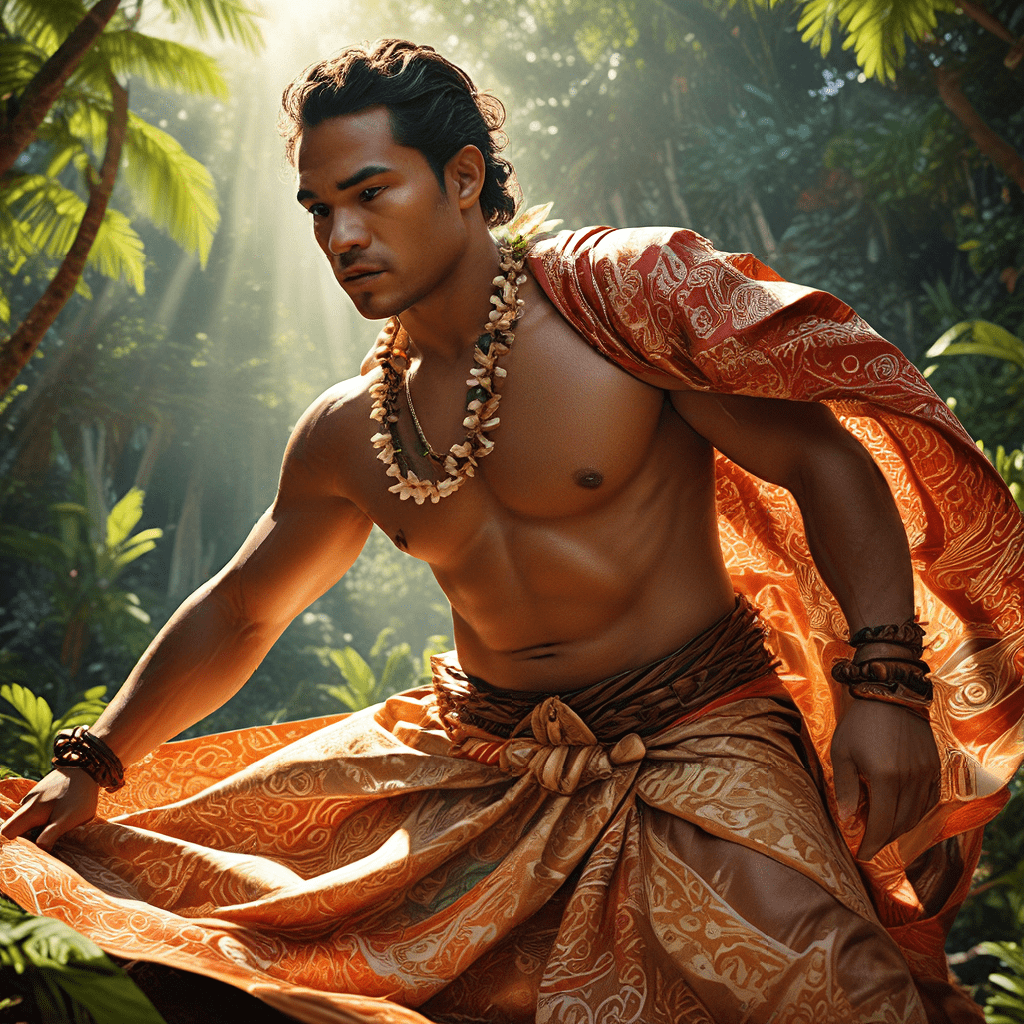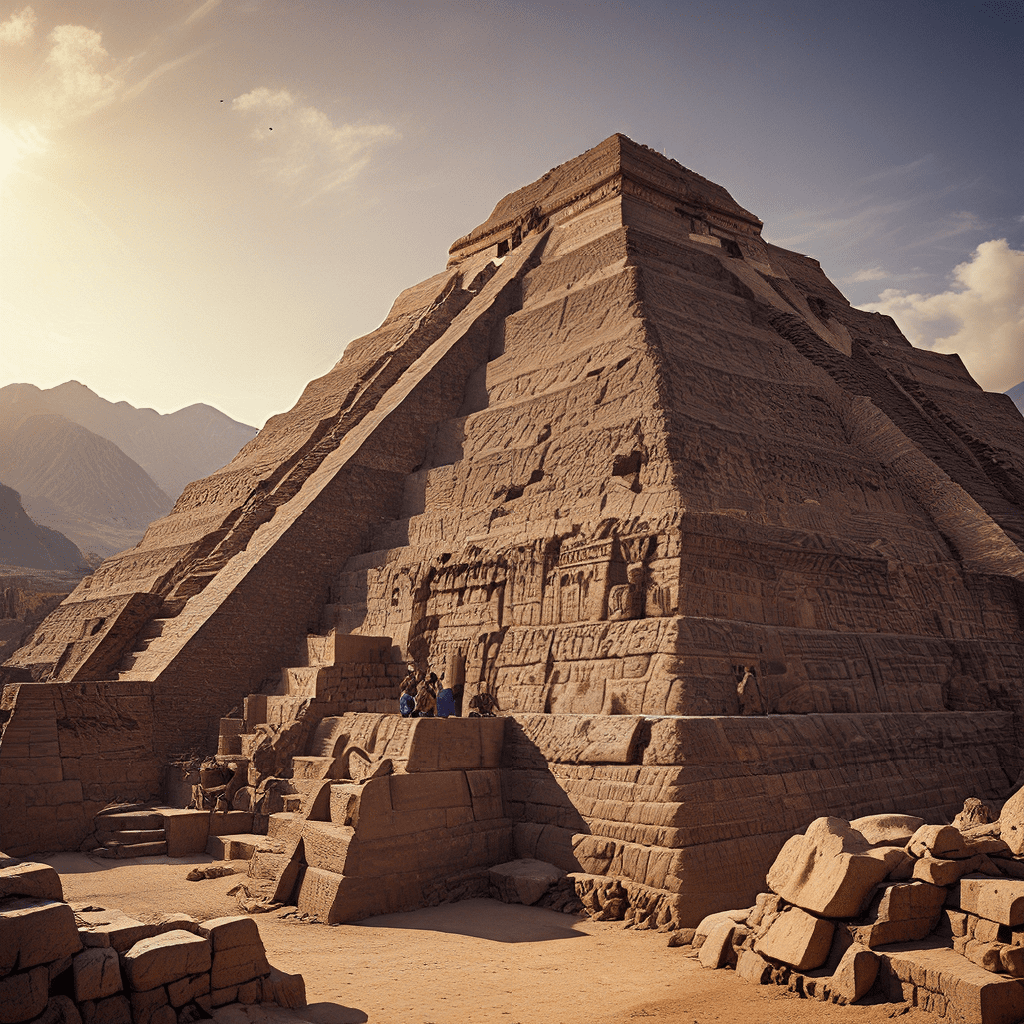The Kapa Cloth: A Sacred Garment in Hawaiian Mythology
In the rich tapestry of Hawaiian mythology, the kapa cloth holds a profound and sacred place. This ancient garment, woven from the bark of the paper mulberry tree, was not merely a piece of clothing; it was an embodiment of Hawaiian culture, history, and spirituality. Kapa was woven into the very fabric of Hawaiian life, playing a vital role in ceremonies, daily life, and social status. It was a symbol of pride, beauty, and the connection between the Hawaiian people and their ancestral lands.
The Creation of Kapa Cloth
The process of creating kapa cloth was a labor of love, requiring patience, skill, and a deep understanding of the natural world. The bark of the paper mulberry tree, known as whaupio, was carefully harvested and soaked in water for several days to soften it. The softened bark was then beaten with a wooden mallet, called an `ii, to create thin, pliable sheets. This beating process was crucial, as it determined the texture and quality of the finished cloth. The sheets were then layered, stitched together, and decorated with intricate designs using natural pigments and dyes.
The Role of the Kapa Cloth in Hawaiian Society
The kapa cloth was not just a garment but served many purposes in Hawaiian society. It was used as clothing, bedding, blankets, mats, and even as a medium for storytelling. The intricate patterns and designs woven into the kapa cloth often depicted stories of gods, heroes, and ancestors, preserving cultural knowledge and traditions.
The Significance of the `I`i (Beater) in Kapa Making
The ii, the wooden beater used in kapa making, was more than just a tool; it was a symbol of craftsmanship and tradition. The ii was often made with intricate carvings and designs, reflecting the artistry and skill of its creator. The act of beating the kapa was a meditative process, requiring a deep understanding of the wood and the desired texture of the cloth.
The Kapa Cloth as a Symbol of Status and Power
The quality and design of the kapa cloth were often indicative of the wearer's social status and power. Chiefs and high-ranking individuals wore the finest kapa, adorned with elaborate patterns and intricate designs. The kapa cloth was seen as a symbol of wealth, lineage, and authority.
Mythological Legends Associated with the Kapa Cloth
In the realm of Hawaiian mythology, the kapa cloth is woven into numerous legends and tales that highlight its significance and connection to the spiritual world. One prominent story revolves around the goddess Hina, who is often associated with the moon and the creation of kapa. Hina's expertise in kapa making is celebrated in many legends, where she is portrayed as a skilled weaver who taught the art to mortals. These tales often depict kapa as a gift from the gods, imbued with spiritual power and meaning.
Another captivating legend relates to the ii* (beater) used in kapa making. The *ii was believed to possess a spirit of its own. This spirit aided the weaver in creating the finest kapa, guiding their hands and imbuing the cloth with its magic. Some tales even narrate that certain `ii had the power to heal and protect those who used them.
These legends emphasize the sacredness of the kapa cloth and its role in connecting the human world with the realm of the gods. They highlight the deep respect and reverence that Hawaiians held for this ancient garment and the traditions associated with its creation.
The Kapa Cloth as a Medium for Storytelling
Beyond its practical uses, the kapa cloth served as a powerful medium for storytelling and preserving cultural knowledge. The intricate designs woven into the kapa cloth were not mere ornamentation; they were visual narratives that conveyed ancient myths, legends, and historical events. Each pattern and design held a specific meaning, allowing generations of Hawaiians to connect with their past and learn about their ancestors, gods, and heroes.
For example, a common design found in kapa cloth is the ulu* (breadfruit). This design represents fertility, abundance, and the interconnectedness of life. Another common design is the *aumakua (family guardian spirit), often depicted as a bird, animal, or mythical creature. This design serves as a reminder of the family's ancestral connection and the protection offered by their guardian spirits.
The kapa cloth acted as a living archive of Hawaiian culture, preserving stories and traditions that would otherwise be lost to time.
The Kapa Cloth in Modern Hawaiian Culture
While the daily use of kapa cloth has diminished in modern Hawaii, its significance and cultural importance remain strong. Today, kapa cloth is still used in traditional ceremonies and celebrations, such as weddings, funerals, and religious rituals. It is also a cherished art form that is actively preserved and taught to younger generations.
Artists and artisans continue to create kapa cloth using traditional techniques, ensuring that this ancient tradition continues to flourish. Modern kapa artists often incorporate contemporary themes and designs into their work. They use natural dyes and pigments, paying homage to the traditional ways of creating kapa. The kapa cloth serves as a bridge between the past and the present, connecting contemporary Hawaiians to their rich cultural heritage.
Theories on the Origins of Kapa Cloth Making
The origins of kapa cloth making are shrouded in mystery, but evidence suggests that this tradition has been practiced in the Pacific region for centuries. Some theories propose that kapa making originated in Southeast Asia, where paper mulberry trees grow abundantly. Others believe that it originated in the Polynesian islands, brought to Hawaii by early voyagers.
Archeological findings in Hawaii have revealed evidence of kapa cloth dating back to the early centuries AD. These discoveries suggest that the tradition of kapa making was established in Hawaii long before the arrival of European explorers.
The Enduring Legacy of the Kapa Cloth
The kapa cloth remains an enduring symbol of Hawaiian culture, history, and spirituality. It is a testament to the ingenuity, artistry, and resilience of the Hawaiian people. From its humble origins as a simple garment to its evolving role in modern Hawaiian culture, the kapa cloth continues to inspire and captivate generations.
The story of the kapa cloth is a testament to the power of tradition, craftsmanship, and storytelling. It is a reminder of the importance of preserving our cultural heritage and celebrating our unique connection to the past.
FAQ
Q: What is kapa cloth?
A: Kapa cloth is a traditional Hawaiian garment made from the bark of the paper mulberry tree. It was used for clothing, bedding, blankets, and ceremonial purposes.
Q: How is kapa cloth made?
A: Kapa cloth is made through a laborious process that involves soaking the bark of the paper mulberry tree in water, beating it with a wooden mallet called an `ii, and then stitching the pieces together.
Q: What is the significance of kapa cloth in Hawaiian culture?
A: Kapa cloth holds great cultural significance in Hawaii. It was used in ceremonies, daily life, and as a medium for storytelling. It was also a symbol of status and power.
Q: What are some of the legends associated with kapa cloth?
A: One prominent legend involves the goddess Hina, who is often associated with the moon and the creation of kapa. Another legend relates to the `ii (beater) used in kapa making, which was believed to possess a spirit of its own that aided the weaver.
Q: How is kapa cloth used in modern Hawaiian culture?
A: Kapa cloth is still used in traditional ceremonies and celebrations in modern Hawaii. It is also a cherished art form that is actively preserved and taught to younger generations.
Q: What is the future of kapa cloth making?
A: The future of kapa cloth making is bright. Artists and artisans continue to create kapa cloth using traditional techniques, ensuring that this ancient tradition continues to flourish.
Q: Where can I learn more about kapa cloth?
A: You can learn more about kapa cloth by visiting museums, cultural centers, and online resources dedicated to Hawaiian history and culture.



